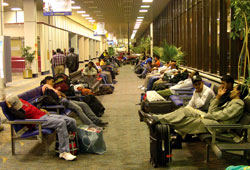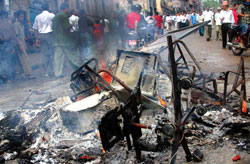
JOMSOM TRAFFIC COPS: Trekkers arriving in Jomsom this
week from Thorung La were surprised to be greeted by these two smart traffic
policemen on duty, Havaldar Durga Kunwar (left) and Havaldar Raju Subedi. Even
though there is no road joining the capital of Mustang district with Tibet or
Baglung yet, there are 125 motorcycles and 16 tractors in Jomsom. Fuel is
transported by mule. There are no traffic jams yet, you can park anywhere you
want, and the main traffic offence is speeding. Jomsom had its first traffic
accident earlier this year when a tractor fell into the Kali Gandaki, killing
two people.
(SANTOSH SHERCHAN)
On the evening of 31 August 2004, news broke of the murder of 12 Nepalis held hostage in Iraq by the terrorist group Ansar-al-Sunna. Normally, rioting stops when night falls. But the vandalism and attacks went on late that night and resumed early the next morning.
By the time curfew was imposed at 2PM, 286 of Kathmandu's 485 overseas employment agencies were destroyed and suffered Rs750 million in damages. Although only one person was reportedly killed, 355 offices, airlines, businesses and media houses had been vandalised. The Jame Masjid was ransacked, and smoke rose from burning tyres all across the city.
Although outrage at the murders and vendetta against recruiters was blamed, it is now clear that all kinds of political forces including the parties, the Maoists, and the royalists were blamed for the organised rioting.
But an underlying reason continues to be ignored: two years after the mayhem, no government body is still actually responsible for the hundreds of thousands of Nepalis who work overseas and prop up the economy.
No one even knows for sure exactly how many Nepalis work abroad, or how much money they send back. There is only piecemeal legislation regulating foreign employment. As the recent crisis in Lebanon showed again, there is no backup for Nepali workers overseas. Manpower agencies often make dodgy deals with foreign employers, or fleece aspiring workers before they even leave the country. Many are dumped at Doha or Kuala Lumpur airport when they get there.
"If you close the door they will leave through the window."
-Saru Joshi, UNIFEM

There are now anywhere between 3.5 million and 4.5 million Nepalis working abroad, no one knows for sure. They send back up to $1 billion to Nepal every year, but no one has an exact count. Every day of this week, 500 Nepalis left for jobs overseas.
It has kept Nepali economy, torn apart by 12 years of insurgency, from collapse. Recent World Bank figures show a 10 percentage point drop in poverty, from 42 to 32 percent, despite the conflict, and the decline is attributed to remittances.
|
|
| Nepali worker at Bahrain airport |
The government's apathy is seen in the woeful lack of statistics. Although there are anywhere up to three million Nepalis working in India at any given time, government records show only one Nepali officially working there. The joke is that it is Manisha Koirala.
The Labour Ministry says that going by the papers it processes over 500 Nepalis leave the country every day for employment elsewhere. But official records show only 175,000 having left in 2004/05. Similarly, while official records show a million Nepalis working and living in India, Ganesh Gurung, who has researched foreign employment for some years, says that the real figure is over three million.
"When the war between Israel and Lebanon started, the government called on manpower agencies to see how many Nepalis were in the region, but could not get the numbers. Much later our estimates showed over 5,000 Nepalis living and working there," says Gurung
|
|
| 1 September 2004 |
The standard response to the killing of 12 Nepalis in Iraq in September 2004 or the exploitation of female domestic workers is a blanket ban. But this doesn't stop the workers from taking the India route.
Saru Joshi, UNIFEM's South Asia Program coordinator, says, "If you close the door, they will leave through the window, if you close the window, they will dig an underground tunnel to leave, there is no stopping those who leave to escape unemployment." The government and agents need to jointly initiate programs on overseas employment and understand the framework in which the labour market operates, she says.
Even problems right in Nepal are not being fixed. Manpower agencies continue to take advantage of the loopholes in Nepal's laws, and many who try to leave for a better life overseas end up losing their land, home, and life savings to agency fees. "People take loans with up to 37 percent interest rate to leave the country, when they start working abroad they are not paid enough so they end up with debt," says Sagar Nepal, vice president of Non Resident Nepali Association (NRNA). There is no follow-up from any side about the living conditions of overseas workers. Says Hafij Khan of Prism Employment Overseas, "The government is too busy sending Nepalis abroad and labour ministry is too busy collecting remittance."
The foreign employment industry, in ruins after the riots, is limping back to life. But overseas labour will remain a potential flashpoint, until the contribution of foreign employment to the Nepali economy is not institutionalised.




